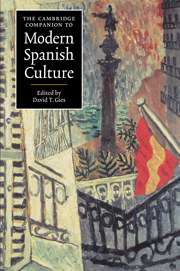Book contents
- Frontmatter
- Modern Spanish culture
- I Culture
- 1 What does it mean to study modern Spanish culture?
- 2 Spain as Castile
- 3 A cultural mapping of Catalonia
- 4 The Basque Country
- II Culture and history
- III Culture and prose
- IV Culture and poetry
- V Culture and theater
- VI Culture and the arts
- VII Media
- Index
- Series List
1 - What does it mean to study modern Spanish culture?
from I - Culture
Published online by Cambridge University Press: 28 May 2006
- Frontmatter
- Modern Spanish culture
- I Culture
- 1 What does it mean to study modern Spanish culture?
- 2 Spain as Castile
- 3 A cultural mapping of Catalonia
- 4 The Basque Country
- II Culture and history
- III Culture and prose
- IV Culture and poetry
- V Culture and theater
- VI Culture and the arts
- VII Media
- Index
- Series List
Summary
Since the present volume deals with modern Spanish culture, it seems crucial to reflect upon the relationships between those three words and the theoretical consequences of how we choose to define culture. I will look first at the changes in the meaning of the word culture in the modern period and then raise some of the theoretical questions that underlie recent scholarship on such topics as high and low culture, gender and culture, culture and politics, and what we mean when we talk about Spanish culture.
The first thing we must do as critics of “modern Spanish culture” is to recognize that the concept of culture which underlies our academic endeavors is itself a modern one. Raymond Williams has reminded us that prior to the late eighteenth century, the word culture did not refer to a static state, or to a standard of intellectual perfection, but to a process. Culture was a synonym for cultivation, and could refer to plants, animals, or human faculties. Williams reads the transformation of the meaning of the word culture as a defensive move responding to the vast economic and social changes unleashed by the industrial revolution - materialism, emphasis on utility, the organization of the working class, and other factors (we might add changes in the role of women). It is important to recall that one of the pre-modern meanings of culture was related to “cult” in the sense of reverence or adoration. This meaning would remain embedded in the new idea of culture, as a higher spiritual state which could be achieved through reading “the best that has been thought and said,” in Matthew Arnold's famous phrase.
- Type
- Chapter
- Information
- The Cambridge Companion to Modern Spanish Culture , pp. 11 - 20Publisher: Cambridge University PressPrint publication year: 1999
- 2
- Cited by



